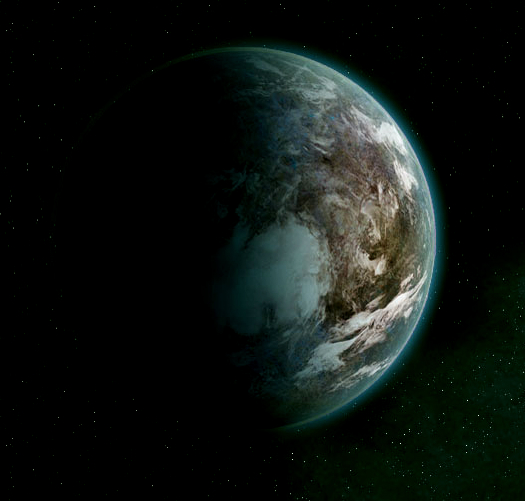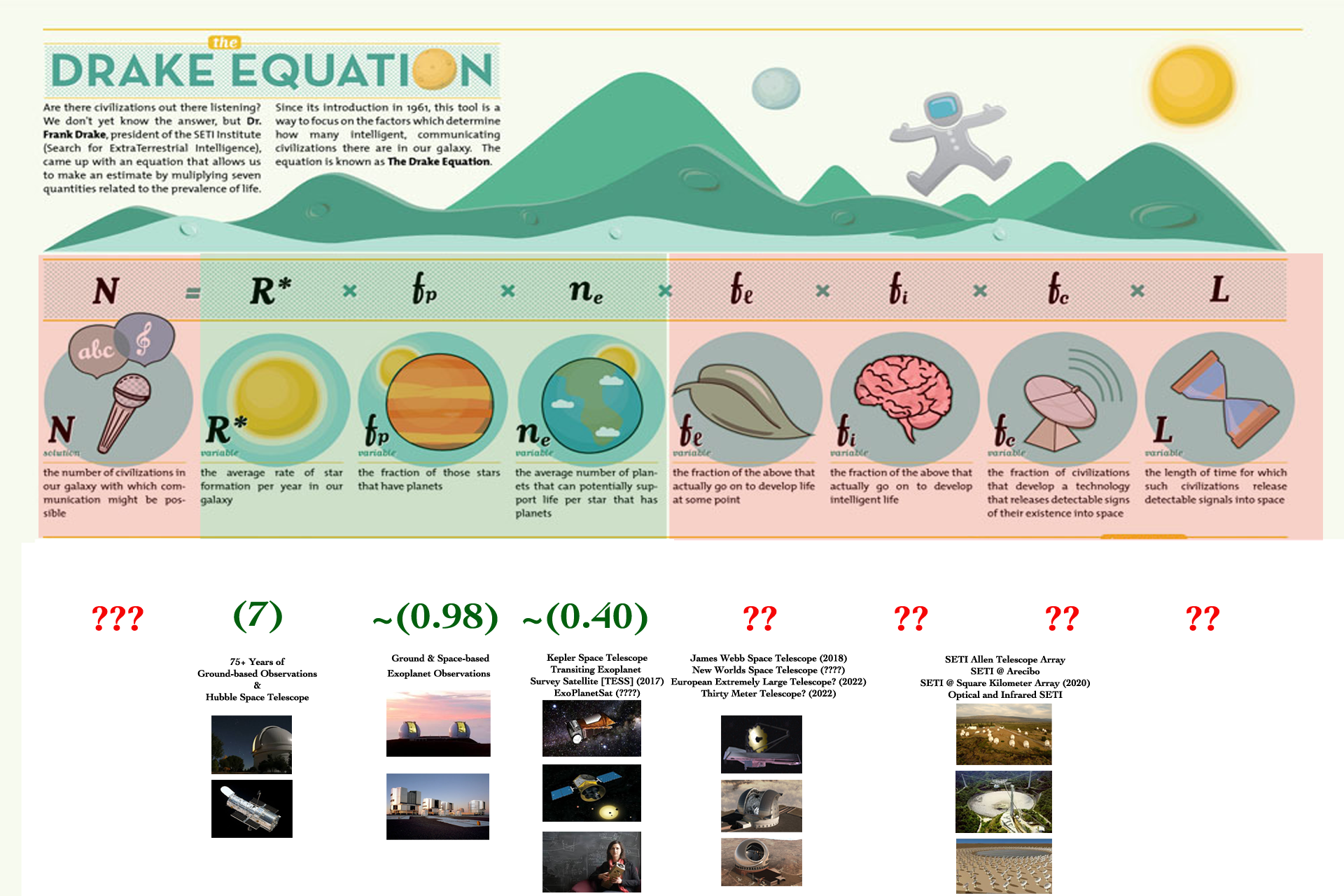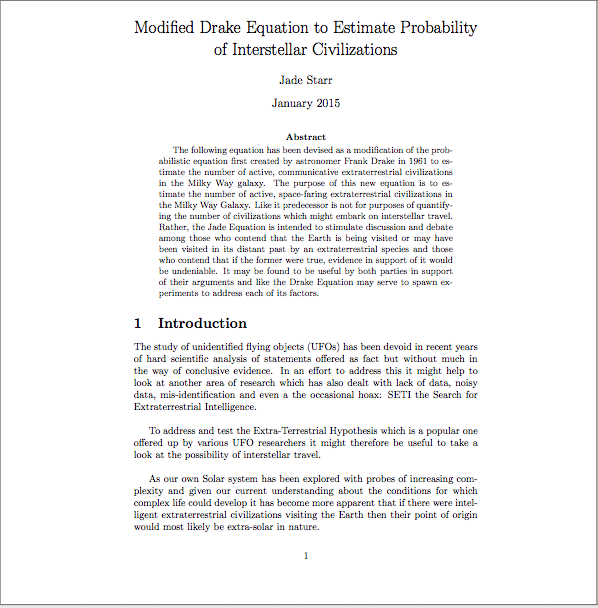It looks like you're using an Ad Blocker.
Please white-list or disable AboveTopSecret.com in your ad-blocking tool.
Thank you.
Some features of ATS will be disabled while you continue to use an ad-blocker.
share:
originally posted by: JadeStar
originally posted by: Erno86
a reply to: JadeStar
In relation to my last post: Three fingers...one of which would be partially opposed.
Are intelligent humanoids --- us --- destined to evolve?
We're evolving right now. Evolution doesn't take a holiday. :-) Evolution of course plays out over long stretches of time though.
Can you postulate or speculate on the theory that if a bipedal warm blooded dinosaur had a chance to evolve into something of a likeness of a Troodon dinosauroid --- would it be destined to evolve [given the proper environmental conditions] --- into a highly intelligent race?
Well we are still learning a lot about both the intelligence capacity of the dinosaurs as well as the development of intelligence in mammals and humans in particular so I would be really just guessing here but if it was advantageous for such a dinosaur to develop intelligence to outwit opponents, find food, nurture young in an environment with stressors pushing it that way then yes, given enough time such a dinosaur could become intelligent in the sense of being high on the EQ scale I posted.
It should be noted that the dinos had a lot longer time than us to develop intelligence and we have no evidence that they developed it or were going to develop it ever. '
For instance, sharks have been around for millions of years but dolphins are more intelligent than they are and appear to have a language. Same environment but totally different outcomes given almost the same amount of time.
Given the fact that dinosaurs evolved first on our planet before the mammals --- including the primates --- What do think are the chances that other typical earth type planets that support carbon based life, will have a certain percentage of [barring catastrophic extinction events] highly intelligent bipedal dinosauroid races?
I don't know.
I would say it is probably a small chance because there could have been many other species which might have become the dominant form of life on Earth had things played out slightly differently.
There could have been giant trilobites dominating the Earth had they not died out before the dinos took over. That's just one example.
Also every planets environment may be slightly different. Who knows what the effect of slightly more or slightly less UV radiation (something which causes genetic mutation) might have had on life on Earth? Yet we know of planets which orbit stars with higher UV output or lower UV output or even no UV output.
One skeptical argument against the occupants reported in association with UFO sightings plays on this fact. The occupants always look too similar to humans.
We don't have stories of 5 foot tall trilobites or intelligent land going octopi. Most alien reports (as in sci-fi) almost always are bi-pedal in nature. In old pre-CGI sci-fi this was understandable because human actors were involved in playing alien roles but evolution as far as we know has no such bias toward bipedalism.
I like the show Falling Skies because the first alien species they introduced were these 6 legged insect like "skitters".
Thanks for your reply.
The Miocene Epoch [23 million to 5.3 million years ago] "is of great importance to primate evolution," so I can say that it took a branch of primates: at least 5.3 million years to evolve into homo sapiens.
Wow!
A truly sparkling, imaginative post remaining within the framework of the cutting edge of modern science.
Like I've said before JS, you also are able to express these interesting scientific topics in a very comprehensible way to those of us who have never studied these topics academically.
Also I'm a bit late catching up with this one as I've had a busy week so please forgive me if people have mentioned these points or asked these questions before. I've not had time to catch up with all the posts. If you have then simply refer me back to the relevant part of the thread.
1) I notice you have mentioned that the "greys" may have come from a planet with more water than Earth. Down the years some people have theorised that dolphins may well be similar in their biology and could evolve into a similar species.
Any thoughts on that possibility?
2) Regarding the Drake Equation. This is still problematic because we simply don't have the data to provide any sort of realistic hard numbers to it.
However are you aware if anyone is working on methods to calculate not only how many alien species could possibly exist but if they could evolve and visit nearby planets/star systems?
(For instance if Mars was confirmed as a living planet back in the dawn of our space age I'm sure we'd have sent astronauts there by now.)
A truly sparkling, imaginative post remaining within the framework of the cutting edge of modern science.
Like I've said before JS, you also are able to express these interesting scientific topics in a very comprehensible way to those of us who have never studied these topics academically.
Also I'm a bit late catching up with this one as I've had a busy week so please forgive me if people have mentioned these points or asked these questions before. I've not had time to catch up with all the posts. If you have then simply refer me back to the relevant part of the thread.
1) I notice you have mentioned that the "greys" may have come from a planet with more water than Earth. Down the years some people have theorised that dolphins may well be similar in their biology and could evolve into a similar species.
Any thoughts on that possibility?
2) Regarding the Drake Equation. This is still problematic because we simply don't have the data to provide any sort of realistic hard numbers to it.
However are you aware if anyone is working on methods to calculate not only how many alien species could possibly exist but if they could evolve and visit nearby planets/star systems?
(For instance if Mars was confirmed as a living planet back in the dawn of our space age I'm sure we'd have sent astronauts there by now.)
a reply to: JadeStar
Ive kind of thought about the tentacles thing as well, octopi seem to do ok with them. As for the webbing that is a good point they may still be tied to the water in some way I guess. That is another thing I wondered, if they lack a reproductive system or just an external one, maybe they breed like fish or amphibians
I'd expect a technological species would have something like fingers or pincers or maybe tentacles which functioned similarly
Ive kind of thought about the tentacles thing as well, octopi seem to do ok with them. As for the webbing that is a good point they may still be tied to the water in some way I guess. That is another thing I wondered, if they lack a reproductive system or just an external one, maybe they breed like fish or amphibians
a reply to: JadeStar
Its an extra super long thread. Even if I wanted I still would not have the time to watch all the vids or click or the links you linked. But ya! Cool stuff anyways I suppose. Makes me kind of what to check out part one, since you said this is part two of your threads. But really, you know, its so long. But I would not bother to much, like all things it will fade into the aether. Besides any premise on the gray are merely brought and put out by analysis on other premises. So really, its sort of like going in circles.
So till we get invaded or the revelations turn out that were already invaded and have been for a long time, or find other planets with life and what not on it, an alien amoeba or alien slug. Its all just much idle pondering you know.
Its an extra super long thread. Even if I wanted I still would not have the time to watch all the vids or click or the links you linked. But ya! Cool stuff anyways I suppose. Makes me kind of what to check out part one, since you said this is part two of your threads. But really, you know, its so long. But I would not bother to much, like all things it will fade into the aether. Besides any premise on the gray are merely brought and put out by analysis on other premises. So really, its sort of like going in circles.
So till we get invaded or the revelations turn out that were already invaded and have been for a long time, or find other planets with life and what not on it, an alien amoeba or alien slug. Its all just much idle pondering you know.
a reply to: Wolfenz
Well how about this? And there were some older cave paintings which dipicted big head short people with what looked a halo around there heads or some sort of helmet. I think those are a bit older then the comics or the stories even of the whole Roswell incident thing.
Indian Cave depiction
Well how about this? And there were some older cave paintings which dipicted big head short people with what looked a halo around there heads or some sort of helmet. I think those are a bit older then the comics or the stories even of the whole Roswell incident thing.
Indian Cave depiction
a reply to: grey9438
Who said octopus could not walk on land, there one of the smartest critters in the sea, so smart that nature has some devious ways of keeping there population in line, one of which is death after matting.
So its far from a stretch that could evolve to walk on landmasses or even to make and create things using there tentacles or even eventually evolve finger like fillers for delicate work and manipulation.
Plenty of vids of octopus walking on land, this one I saw some weeks back, he even had crab which he was caring around and placed it in front of the people for some reason, like a tribute or something, who knows what was going on through its octopus mind.
Who said octopus could not walk on land, there one of the smartest critters in the sea, so smart that nature has some devious ways of keeping there population in line, one of which is death after matting.
So its far from a stretch that could evolve to walk on landmasses or even to make and create things using there tentacles or even eventually evolve finger like fillers for delicate work and manipulation.
Plenty of vids of octopus walking on land, this one I saw some weeks back, he even had crab which he was caring around and placed it in front of the people for some reason, like a tribute or something, who knows what was going on through its octopus mind.
a reply to: JadeStar
Excellent thread I greatly enjoyed reading this.
I noticed you didn't tackle the reasoning as to why The Greys would evolve on another world to look remarkably similar to us - the biological chances would be miniscule wouldn't they?. It seems like an awful long shot that two separate species on two separate planets could both evolve to be bipedal, have a head with two eyes, one nose, two nostrils, one mouth, hands that have fingers like ours etc etc.
Will you be exploring this in another post?
If not, what are your thoughts on this?
Our DNA (assuming the Greys had a genetic structure) would be similar to theirs which means that we diverged at some point either in the past or the Greys are a 'future evolution/time traveller' (I know this is highly theoretical but I'm interested to read a scientific analysis
Thank-you for this insightful thread! S+F
Excellent thread I greatly enjoyed reading this.
I noticed you didn't tackle the reasoning as to why The Greys would evolve on another world to look remarkably similar to us - the biological chances would be miniscule wouldn't they?. It seems like an awful long shot that two separate species on two separate planets could both evolve to be bipedal, have a head with two eyes, one nose, two nostrils, one mouth, hands that have fingers like ours etc etc.
Will you be exploring this in another post?
If not, what are your thoughts on this?
Our DNA (assuming the Greys had a genetic structure) would be similar to theirs which means that we diverged at some point either in the past or the Greys are a 'future evolution/time traveller' (I know this is highly theoretical but I'm interested to read a scientific analysis
Thank-you for this insightful thread! S+F
originally posted by: grey9438
a reply to: JadeStar
I'd expect a technological species would have something like fingers or pincers or maybe tentacles which functioned similarly
Ive kind of thought about the tentacles thing as well, octopi seem to do ok with them. As for the webbing that is a good point they may still be tied to the water in some way I guess. That is another thing I wondered, if they lack a reproductive system or just an external one, maybe they breed like fish or amphibians
Interesting point. It seems humans aren't too interested in deep-sea exploration preffering to focus our gaze skywards. Maybe we are kept out of there for a reason?
a reply to: galadofwarthethird
They actually go a lot further than that, they have been seen using simple tools, and appear to be able to learn things from watching other octopi. So definitely their could be intelligent life forms that have features similar to them. Though I haven't ever heard of people seeing one on board a ufo yet (to go back to the topic of aliens that may be here)
They actually go a lot further than that, they have been seen using simple tools, and appear to be able to learn things from watching other octopi. So definitely their could be intelligent life forms that have features similar to them. Though I haven't ever heard of people seeing one on board a ufo yet (to go back to the topic of aliens that may be here)
Of note: 20 years ago this year was the announcement of 51 Pegasi b as the first planet beyond our solar system orbiting a normal Sunlike star.
October 6, 1995: One of the dates that generations from now will look back at with awe that we did it almost as soon as we had the technology to do so.
Swiss astronomers Michel Mayor and Didier Queloz published the discovery in the journal Nature and then less than a week later on October 12, 1995 American astronomers Geoffrey Marcy and Paul Butler confirmed the discovery by going through data collected by their own San Francisco State University planet search.
By the way: I was born January 7 of the same year or almost exactly 8 months before that announcement
Here's a good summary of how the first ones were discovered as well as other techniques which were developed to find planets in the years after:
One thing to note is that in the 1980s this whole business of finding planets seemed ridiculous to mainstream astronomy.
There were some dubious claims of planets around Barnard's Star and Lalande 21185 in the 1960s and 1980s but they could not be verified, the data was noisy, counter arguments which did not require planets as explanations for what data was there were more plausible and as such they did not exist.
This didn't mean that the idea of planets around another star was invalid and didn't mean that some small bands of astronomers didn't believe they were out there. It just meant there was no solid, undeniable proof to support the claims of their existence.
Because of this, William Borucki, the man who invented the Kepler mission first proposed it in 1985 and was basically laughed out of the room. It was turned down 5 times by various scientific committees. Viewed as too speculative, too visionary, not technologically sound, etc. I saw him at the 2011 Kepler Science Conference and he visibly held back tears of joy when they talked about this and congratulated him as the father of Kepler.
10 years later with the discovery of the first extrasolar planets Kepler gained credibility. That's how science works.
SO HOW ABOUT ALIENS?
I suspect that the way the search for exoplanets played out is a good preview for how the discovery and/or confirmation of how the search for extraterrestrial life and extraterrestrial intelligence will as well.
We'll find one and it will be a worldwide sensation. Then in 20-30 years following that initial discovery, we'll probably know of hundreds or maybe even thousands.
The announcement of finding new planets with alien life or intelligence, like extrasolar planets will then be commonplace news which unless they're a science geek, most people will be bored with just because of sheer numbers and their distance from us.
At the 20 year mark we are now entering a new area shifting from just planet discoveries to planets characterization as well as new discoveries.
Just where are we heading? I give you this from my mentor: Sara Seager
October 6, 1995: One of the dates that generations from now will look back at with awe that we did it almost as soon as we had the technology to do so.
Swiss astronomers Michel Mayor and Didier Queloz published the discovery in the journal Nature and then less than a week later on October 12, 1995 American astronomers Geoffrey Marcy and Paul Butler confirmed the discovery by going through data collected by their own San Francisco State University planet search.
By the way: I was born January 7 of the same year or almost exactly 8 months before that announcement
Here's a good summary of how the first ones were discovered as well as other techniques which were developed to find planets in the years after:
One thing to note is that in the 1980s this whole business of finding planets seemed ridiculous to mainstream astronomy.
There were some dubious claims of planets around Barnard's Star and Lalande 21185 in the 1960s and 1980s but they could not be verified, the data was noisy, counter arguments which did not require planets as explanations for what data was there were more plausible and as such they did not exist.
This didn't mean that the idea of planets around another star was invalid and didn't mean that some small bands of astronomers didn't believe they were out there. It just meant there was no solid, undeniable proof to support the claims of their existence.
Because of this, William Borucki, the man who invented the Kepler mission first proposed it in 1985 and was basically laughed out of the room. It was turned down 5 times by various scientific committees. Viewed as too speculative, too visionary, not technologically sound, etc. I saw him at the 2011 Kepler Science Conference and he visibly held back tears of joy when they talked about this and congratulated him as the father of Kepler.
10 years later with the discovery of the first extrasolar planets Kepler gained credibility. That's how science works.
SO HOW ABOUT ALIENS?
I suspect that the way the search for exoplanets played out is a good preview for how the discovery and/or confirmation of how the search for extraterrestrial life and extraterrestrial intelligence will as well.
We'll find one and it will be a worldwide sensation. Then in 20-30 years following that initial discovery, we'll probably know of hundreds or maybe even thousands.
The announcement of finding new planets with alien life or intelligence, like extrasolar planets will then be commonplace news which unless they're a science geek, most people will be bored with just because of sheer numbers and their distance from us.
At the 20 year mark we are now entering a new area shifting from just planet discoveries to planets characterization as well as new discoveries.
Just where are we heading? I give you this from my mentor: Sara Seager
edit on 10-1-2015 by JadeStar because: (no reason given)
a reply to: JadeStar
In relation to my last post...I'm suggesting that maybe one of Earth's dinosaur species weren't given sufficient time to advance into a highly advanced species, due to the catastrophic extinction event of the dinosaurs.
But I'm guessing that you'll agree with me: That if any advanced civilization is going to survive the eventual death of it's own home star --- it must achieve the ability of transporting a portion of its own civilization to another star system --- if it's going to survive.
How many civilizations have achieved this technological feat of interstellar travel is unknown --- but I'm sure it's a given --- due to an extent that I had my own eyewitness alien starship sighting --- one night in November, 1976 --- approximately 40 miles west of Washington D.C.
In relation to my last post...I'm suggesting that maybe one of Earth's dinosaur species weren't given sufficient time to advance into a highly advanced species, due to the catastrophic extinction event of the dinosaurs.
But I'm guessing that you'll agree with me: That if any advanced civilization is going to survive the eventual death of it's own home star --- it must achieve the ability of transporting a portion of its own civilization to another star system --- if it's going to survive.
How many civilizations have achieved this technological feat of interstellar travel is unknown --- but I'm sure it's a given --- due to an extent that I had my own eyewitness alien starship sighting --- one night in November, 1976 --- approximately 40 miles west of Washington D.C.
edit on 10-1-2015 by Erno86 because: spelling
originally posted by: Erno86
a reply to: JadeStar
In relation to my last post...I'm suggesting that maybe one of Earth's dinosaur species weren't given sufficient time to advance into a highly advanced species, due to the catastrophic extinction event of the dinosaurs.
But I'm guessing that you'll agree with me: That if any advanced civilization is going to survive the eventual death of it's own home star --- it must achieve the ability of transporting a portion of its own civilization to another star system --- if it's going to survive.
Yes I'd agree with that.
a reply to: Kalixi
The OP can probably answer this better than me, but it could be a case of parallel evolution, where distantly related creatures in similar roles develop similar features or even can look alike. Like the case of Australian marsupial vs placental mammals that are more distantly related, www.britannica.com...
Now we would go to the idea that an alien species in order to do the things that humans have done in order to build our civilization they may develop adaptations they may develop similar features. This is the simplified idea . It has been highly debated and most scientists think the idea that the human body design as the prefect one of an intelligent species is just ego on our behalf. But could explain why most aliens encountered by people are humanoid in form.
I noticed you didn't tackle the reasoning as to why The Greys would evolve on another world to look remarkably similar to us - the biological chances would be miniscule wouldn't they
The OP can probably answer this better than me, but it could be a case of parallel evolution, where distantly related creatures in similar roles develop similar features or even can look alike. Like the case of Australian marsupial vs placental mammals that are more distantly related, www.britannica.com...
Now we would go to the idea that an alien species in order to do the things that humans have done in order to build our civilization they may develop adaptations they may develop similar features. This is the simplified idea . It has been highly debated and most scientists think the idea that the human body design as the prefect one of an intelligent species is just ego on our behalf. But could explain why most aliens encountered by people are humanoid in form.
STARRED AND FLAGGED !
What great read on a weekend.
My first thought was to the reports that greys are not actually the extraterrestrial conscious life forms but a bio-robot created by something else, used in deep space travel (some say are part of the craft itself) to feed back information.
According to secret alien interviews that is
Makes your whole thread moot, but who cares!
What great read on a weekend.
My first thought was to the reports that greys are not actually the extraterrestrial conscious life forms but a bio-robot created by something else, used in deep space travel (some say are part of the craft itself) to feed back information.
According to secret alien interviews that is
Makes your whole thread moot, but who cares!

I guess this next post could be labelled: "File Under: How Aliens Could Detect the Earth"
So, I was going through my usual scientific paper reading on a Saturday morning and came across this short paper on NASA's Kepler K2 mission science site entitled: K2 Exoplanet Ecliptic Survey – KEES
In the paper the authors use our current capabilities with Kepler to think about what aliens (called "External observers" in the paper) in a planetary system called WASP-47, discovered around 1,000 light years away in the constellation Scorpius could tell about the Earth if they had their own Kepler-like spacecraft observing our Sun. The paper is proposing we do a similar search as the one it postulates the "External observers" could have done or be doing.
It underscores the point I made in the original post against skeptics who might suggest our planet would not even be noticed by aliens a thousand light years away or more.
Not only would they know the Earth was habitable but they'd have known it for a long time.
Here are some not-too-jargon filled excerpts from the paper:
K2 Exoplanet Ecliptic Survey – KEES
Christopher J. Burke, F. Mullally, & Daniel Huber – SETI Institute, Nasa Ames
For billions of years the Earth’s shadow against the Sun has swept a path through space revealing our existence to our
stellar neighbors within 0.26 degrees of the ecliptic. Photometric observations of the quality obtained by Kepler performed at our ecliptically aligned stellar neighbors can discover the Earth transiting the Sun (Figure 1). We propose to survey all GKM dwarf stars within 0.26 degrees of the ecliptic using the K2 spacecraft in order to identify transiting planetary systems that can mutually discover Earth via transit observations performed by another civilization. (emphasis theirs)
So basically what they are stating is that for billions of years our Earth has transited our Sun for any aliens with something like our Kepler, within 0.26 degrees of the ecliptic. They are proposing to look at Sunlike (GK) and M-dwarf stars within 0.26 degrees of the ecliptic with the ressurrected Kepler K2 mission "in order to identify transiting planetary systems that can mutually discover Earth via transit observations performed by another civilization".
So in other words they want to look for planets around stars which may have planets and aliens who already would know we're here.
Continuing...
This survey will significantly expand the number of ecliptic aligned planets known from the two Jupiter-class planets (WASP-47b – Hellier et al. 2012 ; and the direct imaging discovered 5 Myr old 1RXS-J160929b – Lafreni`ere et al. 2008) into the regime of Super-Earth size planets. The primary goal is to generate a catalog of planet candidates for prioritizing SETI searches. Secondary goals are to follow up the most favorable candidates for asteroseismic stellar characterization and radial velocity follow up. With K2 data it will also be possible to search these targets for artificial transiting structures (Arnold 2013) and non-astrophysical time variable signals. (Walkowicz et al. 2014) (emphasis mine)
Translation (my comments are in parenthesis like this one is):
This survey will add to the amount of planets aligned with the ecliptic from two Jupiter sized planets to a whole host of SuperEarth type planets which might know we're here. (Intriguing in light of the original post isn't it?) The primary goal is to create a catalog of planet candidates for prioritizing targeted SETI searches. (The reasoning being that it might make more sense to search for signals and other detectable things from planets which already know the Earth exists.) Secondary goals are to follow up the most favorable candidates for radial velocity characterization (which could reveal the planets mass and thus density). With data from this K2 mission it will also be possible to search these planetary systems for artificial or alien constructed transiting structures (think massive space stations/colonies, Dyson Shells, Ringworlds, or other things of immense proportion we have never dreamed up) and non-astrophysical (alien) time variable signals (due to alien technology).
Continuing....
External observers along the ecliptic can make direct geometrical measurements of the Earth’s radius through transits and asteroseismic determinations of the Sun’s radius (Huber et al. 2013). An accurate and precise radius, coupled with radial velocity and/or astrometry observations, yields an accurate and precise measurement of Earth’s density. Non-ecliptic observers of Earth would have to rely upon challenging (to us currently) interferometric or indirect radius estimate via bolometric flux and albedo estimates (Schneider et al. 2010) making it difficult to confirm the rocky nature of Earth (Rogers & Seager 2010). Thus, we conjecture that external observers along the ecliptic may prioritize communicating with Earth after having confirmed its rocky nature. In addition, SETI followup during secondary eclipse may detect non-thermal or narrow band transmissions emanating from the planet.
Translation:
Aliens who live on planets along the ecliptic could make direct geometric measurements of the Earth's radius from using something like Kepler and make astroseismic determinations of our Suns radius to characterize it. An accurate and precise radius, coupled with radial velocity and/or astrometric observations, would tell the aliens how dense our Earth is (ie: whether or not it was a rocky planet, a mini-Neptune, a water world, etc). Aliens not along the ecliptic would have to rely upon more complex (for us currently) technology to derive that density or use indirect radius estimates which would make it difficult to confirm our Earth was rocky in nature. Thus, they suggest that aliens along the ecliptic might prioritize communicating with Earth after having confirmed it was a rocky planet and thus somewhere ripe for life. In addition the alien SETI followup during secondary eclipses might detect artificial heat sources due to technology or narrow band radio communications coming from Earth.
See there, I just turned a paper most people in the UFO field would never have given second thought to (due to its title and the language barrier) into a pretty interesting proposal from within NASA Ames Research Center which suggests "external observers" could already know about the Earth.
Yet another reason why it would behove very serious UFO researchers to become a bit more science aware and versed in the language of astronomy. Who knows what other papers sit in the open on public servers which could potentially be used in counter arguments against debunkers.
SIDENOTE: I am a UFOs as evidence of alien contact skeptic, but I am not a debunker. There's a difference. One uses rationality to constrain a problem and rule out the implausible. The other does not bother looking at the problem and rushes to judgement out by painting with a broad brush.
I am happy if you call me a skeptic but please do not call me a debunker. One is science. The other is not.
edit on 10-1-2015 by JadeStar
because: (no reason given)
originally posted by: galadofwarthethird
a reply to: Wolfenz
Well how about this? And there were some older cave paintings which dipicted big head short people with what looked a halo around there heads or some sort of helmet. I think those are a bit older then the comics or the stories even of the whole Roswell incident thing.
Indian Cave depiction
let alone from India
Dont for get the Australian ancient Painting s too The Wandjina

And Japans Figures looking similar to those Australian Paintings
Ancient Aliens...The best evidence
www.abovetopsecret.com...

If you look At Ancient Figurines they are all over ! on Legit museum Websites or in Person ...
Resembling those Large Headed Large Eyed Dwarfen or Elven Looking Beings..
It all in The State Of Mind in How you Represent them! Aliens or Gods
Its Obviously its Something of Ancient Man of Races and Culture Has Seen ( or was Told About Their Description ) the Same thing Around the World...
As I said Before Many Times Modern Man Has been on this Planet for over 250,000 years
and THE " Remaining " Recorded history only been around 6 to 8 thousand years.
Pretty Much its like what the Myths and Legends , Tales of Dragons, Unicorns & Giants and Little People been Around the World... Telling the Same thing .. let Alone The Attributes and Virtues .. of Gods Deites & Angels Saying the Same Thing in Each Religion and Culture ....
Its Either of What Ancient Modern Humans has Seen or was influenced by others ... Travelers & Foreigners ..
Best example is if anyone Remembered or Heard of the Cargo Cult back in the 40s
The Cargo Cults
of the South Pacific
www.sjsu.edu...


My Guess
In Ancient IRAN & IRAQ They Did the Same !

edit on 62015SaturdayfAmerica/Chicago19 by Wolfenz because: (no reason given)
originally posted by: mirageman
Wow!
A truly sparkling, imaginative post remaining within the framework of the cutting edge of modern science.
Like I've said before JS, you also are able to express these interesting scientific topics in a very comprehensible way to those of us who have never studied these topics academically.
I grew up reading Carl Sagan and marvelled at his ability to do the same. I think it is valuable that the average person in the street know what is going on in the halls of academia because the more people know, the more apt they are to have a favorable view of what we do. We don't own this research. Knowledge about the universe is the property and birthright of all of humanity. So it makes sense to communicate what we know and how we know it in a language everyone can understand.
Also I'm a bit late catching up with this one as I've had a busy week so please forgive me if people have mentioned these points or asked these questions before. I've not had time to catch up with all the posts. If you have then simply refer me back to the relevant part of the thread.
Ok.
1) I notice you have mentioned that the "greys" may have come from a planet with more water than Earth. Down the years some people have theorised that dolphins may well be similar in their biology and could evolve into a similar species.
Any thoughts on that possibility?
It's an interesting possibility. I think it is based on the same color skin but we do know on Earth that dolphins have a language and people at the SETI Institute have done research into communicating with dolphins:
SEE ALSO: Dolphins, Aliens and the Search for Intelligent Life - Astrobiology Magazine, August 29, 2011
Could a species similar to dolphins on another world evolve to going onto land and building a civilization? As Sara Seager says, "Anything is possible within the laws of chemistry and physics". Nothing in chemistry or physics would rule out such a possibility so why not?
2) Regarding the Drake Equation. This is still problematic because we simply don't have the data to provide any sort of realistic hard numbers to it.
Actually we do now have some data that fills in some of it but it is far from complete as you know.
Did you read my ATS thread on the Drake Equation? - ATS: The Drake Equation - Illustrated and Clarified (INFOGRAPHIC)

More on that graphic I made at the link above.
However are you aware if anyone is working on methods to calculate not only how many alien species could possibly exist but if they could evolve and visit nearby planets/star systems?
Well I don't know anyone who has done this specifically but you really could make "fc" in the Drake Equation "fs" (fraction of civilizations which develop space travel) since we developed transmitters powerful enough to be detected at interstellar distances around roughly the same time we began to launch stuff into space. One could then add another fraction "fv" which would be the fraction of space travelling civilizations which launch things at velocities which could reach a nearby star system within some arbitrary set period of time (human life time? human generation?).
So it would look something like:


(For instance if Mars was confirmed as a living planet back in the dawn of our space age I'm sure we'd have sent astronauts there by now.)
Absolutely. It would be a prime motivator.
edit on 10-1-2015 by JadeStar because: (no reason given)
edit on 10-1-2015 by _BoneZ_ because: Edited at JadeStar's request.
I'd say the Drake equation needs a lot more terms, even to predict the probability of communication.
For one, what causes minerals to be close enough to the surface to mine? You have to have minerals, metals, rare metals to construct technology.
What if there is constant cloud cover and no mountains above it to put devices like telescopes and arrays?
What if the area of space has obstacles to radio wave transmission, higher incidence of bombardment so the sentient race has to live underground?
The terms used now are necessary but perhaps not sufficient.
For one, what causes minerals to be close enough to the surface to mine? You have to have minerals, metals, rare metals to construct technology.
What if there is constant cloud cover and no mountains above it to put devices like telescopes and arrays?
What if the area of space has obstacles to radio wave transmission, higher incidence of bombardment so the sentient race has to live underground?
The terms used now are necessary but perhaps not sufficient.
originally posted by: zazzafrazz
STARRED AND FLAGGED !
What great read on a weekend.
My first thought was to the reports that greys are not actually the extraterrestrial conscious life forms but a bio-robot created by something else, used in deep space travel (some say are part of the craft itself) to feed back information.
According to secret alien interviews that is
Makes your whole thread moot, but who cares!
Good point zazzafrazz. Yes, this whole thread is moot. You could learn more about the greys on the back of a cereal box than you will from this thread. Jadestar's ?analysis? is so superficial as to ignore almost every physiological and psychological aspect of these beings. Instead, she perfers to guess wildly as to their world, like a little girl guesses what land unicorns come from.
And that's what so many at ATS come here for, to treat the alien situation as if it were a guessing game, endlessly going around and around with speculation. Like the questions of aliens were just a mental exercise to wonder about idly, to attach your own personal notions to an imaginary alien.
I mean face it, people, jadestar here ADMITS she thinks GREYS ARE NOT REAL. For Pete's sake, how seriously can one take her treatment of the issue?
edit on 10-1-2015 by Scdfa because: (no reason given)
new topics
-
OK this is sad but very strange stuff
Paranormal Studies: 2 hours ago -
Islam And A Book Of Lies
Religion, Faith, And Theology: 4 hours ago -
Sorry to disappoint you but...
US Political Madness: 6 hours ago -
Watch as a 12 million years old Crab Emerges from a Rock
Ancient & Lost Civilizations: 11 hours ago
top topics
-
Sorry to disappoint you but...
US Political Madness: 6 hours ago, 13 flags -
ILLUMINATION: Dimensions / Degrees – Da Vincis Last Supper And The Philosophers Stone
Secret Societies: 17 hours ago, 9 flags -
Watch as a 12 million years old Crab Emerges from a Rock
Ancient & Lost Civilizations: 11 hours ago, 9 flags -
Islam And A Book Of Lies
Religion, Faith, And Theology: 4 hours ago, 5 flags -
OK this is sad but very strange stuff
Paranormal Studies: 2 hours ago, 5 flags
active topics
-
Tesla Cybertruck Explodes in Front of Trump Hotel in Las Vegas
Mainstream News • 229 • : Daughter2v2 -
Musk calls on King Charles III to dissolve Parliament over Oldham sex grooming gangs
Mainstream News • 179 • : NoCorruptionAllowed -
What Is 'Quad Demic'? Mask Mandate Returns In These US States
Diseases and Pandemics • 39 • : AdultMaleHumanUK -
Meta Llama local AI system is scary good
Science & Technology • 38 • : glend -
Sorry to disappoint you but...
US Political Madness • 13 • : nugget1 -
OK this is sad but very strange stuff
Paranormal Studies • 2 • : Ravenwatcher -
Winter Storm
Fragile Earth • 33 • : rickymouse -
Stuck Farmer And His Queue Jumping Spawn
Rant • 5 • : rickymouse -
Speaking of Pandemics
General Conspiracies • 4 • : rickymouse -
Trump's idea to make Canada the 51st US state: 'Potential is massive'
Mainstream News • 154 • : WeMustCare
